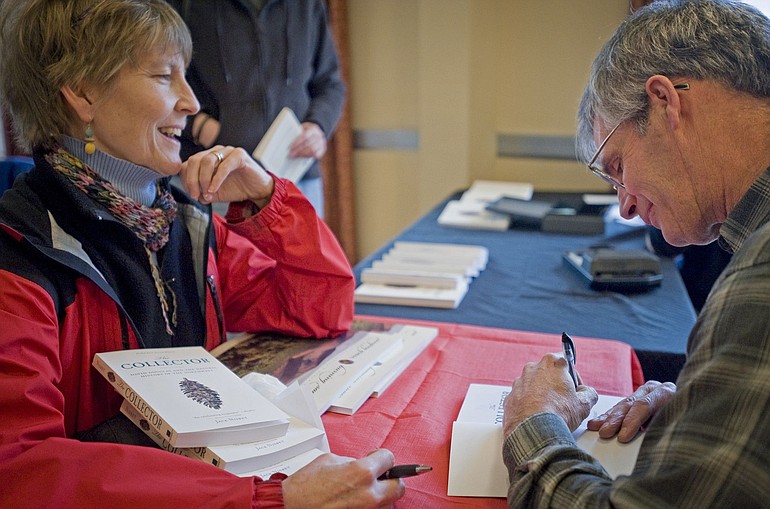o What: Author Jack Nisbet will read from his new book, “The Collector: David Douglas and the Natural History of the Pacific Northwest.”
o When: 7:30 p.m. today
o Where: Powell’s Books, 1005 W. Burnside St., Portland
o Cost: Free.
If you had lived here almost 200 years ago, you likely would have known naturalist David Douglas. Certainly your children would have.
In fact, the Scotsman who was one of the first trained botanists to explore the Pacific Northwest knew almost everyone at Fort Vancouver and the vast, thinly populated area from which the fur trading empire drew. “I think he was quite fun to go out (exploring) with,” said Spokane author Jack Nisbet, author of a new book on Douglas, “The Collector: David Douglas and the Natural History of the Pacific Northwest.”
As the Center for Columbia River History’s first Michael M. Powell fellow, Nisbet was in Vancouver on Sunday, where he discussed Douglas and his ties to Fort Vancouver, the Hudson’s Bay Company’s 19th-century fur trading post.
Douglas was an important naturalist, documenting more than 500 plant species in his eight years in the region. The Douglas fir, a staple of western Cascades forests and a very popular Christmas tree, bears his name.
But equally important was his ability to make connections with fur trappers, traders, their Native American wives and relations, and their children. By doing so, he was able to document the history, range and use of plants far beyond what a man could walk around and observe, Nisbet said.
Born in Scotland, son of a stone mason, Douglas grew up without the chance at a large inheritance. That put him in perfect company with the majority of the Hudson’s Bay Company traders, many of whom were second sons whose lot was to find their own fortune in the world.
That’s also how, Nisbet said, Douglas found himself on a ship from New York, around Cape Horn, to the Pacific Northwest. Having studied under famed English botanist William Jackson Hooker, a lifelong mentor, Douglas used his people skills to talk his way into an appointment with the Royal Horticultural Society of London to survey Northwest plants.
A life-long fisherman, the crew liked him because he would land fresh seafood caught over the side of the ship. He wasn’t above showing his cooking skills, and after a call in the Galapagos Islands — years before Charles Darwin — acquired a reputation for his delicious iguana stew.
He arrived at Fort Vancouver in April 1825, and was welcomed to the region by Chief Factor Dr. John McLoughlin with a box full of rocks from the Rocky Mountain region. The trading post was in its infancy, in temporary quarters east of where the re-created Fort Vancouver stands today. He lived at first in a tent, then, as winter rains arrived, moved in with McLoughlin, his Indian wife and their children in their half-finished house.
At Fort Vancouver he was interested in plants, of course, and quite possibly everything else. The children knew him as an interesting playmate, prone to digging, exploring and other things kids like to do. Ranald Macdonald, the son of a Fort Vancouver fur trader who grew up to become the first man to teach English in Japan, fondly recalled Douglas as a friend in his youth.
Douglas documented and introduced into cultivation a variety of Northwest native trees, and tested them for their commercial lumber suitability.
Douglas was particularly interested in finding sources of wild tobacco, then as now a major commercial product. Nisbet recalled that Douglas once stumbled into a patch of Indian tobacco plants in a concealed area of the lower Willamette Valley. He had just finished collecting a sample when he was accosted by the grower.
That was one time his people skills came in handy, Nisbet said.
After several years in the region, he took a long overland trip through Canada to Hudson’s Bay, and then on to London, where he wrote and contributed to scientific papers. After it was apparent that London wasn’t his calling, he made his way back to the Northwest, returning to Fort Vancouver in 1830. But so much had changed, he soon set out for the wilderness.
He branched out, exploring California’s Mission Trail and later Hawaii. It was there that he died in 1834, far beyond his Pacific Northwest social network, when he fell into a pit trap and was crushed while climbing Mauna Kea with only his dog. He was 35 years old.
“There was nobody there to pull him out,” Nisbet explained. “It was one of the few times he was alone.”
Craig Brown: 360-735-4514; craig.brown@columbian.com.




